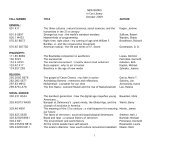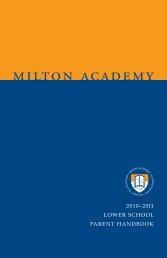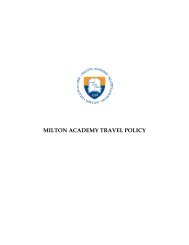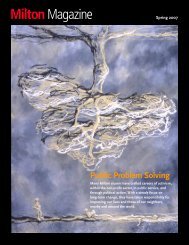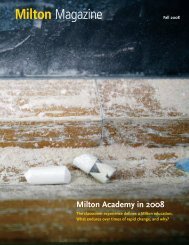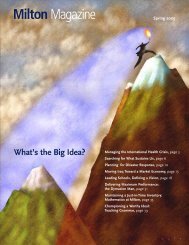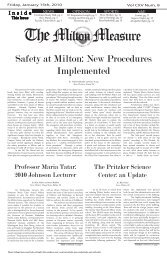Post ScriptTreasures in unexpected places:Caring for discoveries at HarvardEmmy Norris ’62Imagine opening the door to a utility closet and findingon a shelf inside some long-forgotten film footage of theelderly Pierre-Auguste Renoir. The artist is seated in awheelchair, talking to his dealer and to his model. Withhim are Ambrose Vollard, his dealer, and “La Boulangère,”his longtime model and servant. It is the only knownfootage of Renoir; it is also the only known film of anyFrench impressionist. The film was found because a phonecall to a retired department administrator jogged her memoryof an old film canister up on a shelf behind the Dranoand the paper towels.This happened in May 2001 at Harvard University. But itcould happen anywhere.Old institutions like Harvard often have a bewildering varietyof objects that are not catalogued. There is little informationon works owned by its various units; they sometimesdisappear or suffer considerable environmental damagebecause nobody is looking out for them. Such objectsmay be works of art, antique furniture and carpets, silvertrophies, donations that should be tracked, and other itemsof monetary, artistic or cultural interest. Their acquisitionby its nature has been haphazard. It shouldn’t be a surprisethat the documentation has been haphazard as well.I first became interested in these scattered objects when Iwas a curator at the Harvard University Art Museums.Assorted Harvard-owned artworks, frequently called“orphans” by museum staff because they were undocumentedand unsupervised, would arrive for conservationtreatment after somebody noted a torn canvas or damagedsculpture or butter on a painting in a dining room. Theworks were treated and then sent back, since the art museums,overwhelmed with their own collections, could notundertake managing additional objects.The most famous example of neglect was a series ofmurals painted by Mark Rothko. In the early 1960s, theartist completed a series of large “color field” murals oncommission from Harvard, in the penthouse of HolyokeCenter, the university’s chief administration building.Rothko bought cheap paints, and the light levels in thepenthouse were high. Nobody checked on the muralsbecause there was no procedure in place to do so, and theygradually deteriorated. By the ’70s, the murals’ rosy colorshad faded from excessive light exposure and the effect wassomething like an x-ray of the originals. The murals arenow stored at the Fogg Art Museum, but their colors haveessentially died.It seemed to me that it was high time for the university tomanage these unsupervised objects scattered throughoutthe campus, and I was interested in doing the job myself.In 2000, armed with facts, figures and photos, I persuadedHarvey Fineberg, former university provost, to fund a survey.The selling points were numerous: good inventory50 <strong>Milton</strong> Magazine
Emmy Norris is a prowler for “cultural properties” at Harvard,preserving and insuring important artifacts.control; improved alumni and development relations; alertingof departments to the presence of significant works;information for the general public; clarification of legal status;documentation for the insurance office; and, of course,periodic supervision. In many cases, Harvard did not knowwhat it had. People retire and take stories with them; whatone person considers disposable may in fact have considerablevalue; something that was “always there” appreciatedgreatly in value over the centuries.The survey of these objects, called “cultural properties” forlack of a better word, has just been completed after threeyears. Now that Harvard knows what it has, we can workwith the information to make policy decisions as to theirtreatment, deaccession, publicity and so forth.The work itself was simple: I went with an assistantthrough Harvard properties with a tape measure, laptopcomputer and digital camera. We worked building bybuilding, having first contacted department heads andbuilding managers. We asked for their suggestions as towhat to include and then we took a look around. It isalways worth taking a personal look; only with physicalinspection can it be determined what is important, what isdeteriorating, and what is in the wrong place. We gatheredbasic museum information—object type, artist, title, century,materials used, donor, measurements, etc.—as well as adigital photo. If the object was deteriorating or neededextra security, we flagged that entry and advised the departmentin charge. The survey has taken us to Sutton Islandand Kittery Point in Maine, Washington, D.C., numeroussites west of Boston—including historic houses, an oldNIKE missile site, the Harvard Forest and the Oak RidgeObservatory—as well as the campuses in Cambridge,Boston and Allston. The database contains some 3,500objects from all parts of Harvard except for the Law School,which prefers to keep its own records.We never knew what would turn up, and so the vague definitionof “cultural properties” expanded as we went along.Examples include Josiah Quincy’s walking stick; Edward R.Murrow’s beat-up old desk; a beautiful old surveyor’sinstrument; gorgeous stained glass and late-19th-centurytiles; 19th-century teaching aids; the football that won the1920 Rose Bowl; Civil War–era baseballs; and buggies andsleighs.Information about these objects has been most useful tovarious departments of the university. This would be trueat other sites, where valuable objects are not tracked. Somany fine things disappear from old institutions; I thinkparticularly of private schools, colleges and private clubs.I urge those involved with these to take a closer look andtake appropriate action, rather than waiting to close thebarn door until the horse is stolen.Reach Harvard’s curator of unexpected discoveries atenorris@camaid.harvard.edu.51 <strong>Milton</strong> Magazine
- Page 3 and 4: 283440Journalism at Milton24 Studen
- Page 6 and 7: One piece of AOL programming that h
- Page 8 and 9: puter) and read a piece. Bored? Pro
- Page 10 and 11: decrease in the amount spent on res
- Page 12 and 13: “The biggest change is corporatei
- Page 14 and 15: Jesse Sarles ’93“It’s a flexi
- Page 16 and 17: Felicia Taylor ’82Ned Roberts ’
- Page 18: “I don’t go through a lot of me
- Page 21 and 22: This summer, Peter was in the midst
- Page 23 and 24: Ty Burr ’76“On one level what I
- Page 25 and 26: Later, she enjoyed stints at Workin
- Page 27 and 28: were what to get into at Milton. Ma
- Page 29 and 30: Charlie Riggs, Abby Padien-Havens,
- Page 31 and 32: They say that the tough part was th
- Page 33 and 34: Co-editors of La Voz, 2005:Emma San
- Page 35 and 36: In its three to four annual issues,
- Page 37 and 38: 6 Sam Minkoff ’06 andJamal Sabky
- Page 39 and 40: Student graduation speakers Tanner
- Page 41 and 42: The Robert L. Daley PrizeCreated by
- Page 43 and 44: 1 Llewellyn Howland ’552 Derick F
- Page 45 and 46: 11 Robin Robertson with the MiltonM
- Page 47 and 48: The Head of SchoolMilton’s Magazi
- Page 49 and 50: I began to inventory the sensations
- Page 51: Hadley Davis Rierson ’89speaking
- Page 55 and 56: A collection of symbols, none more
- Page 57 and 58: Middle School Tackles Complex Probl
- Page 59 and 60: Gratwick Performersdents prior to t
- Page 61 and 62: He changed his mind, though,soon mo
- Page 63 and 64: Creating Cityscapes:Third-grade stu
- Page 65 and 66: New Roles for Milton Faculty Member
- Page 67 and 68: Hugh R. SilbaughUpper School Princi
- Page 69 and 70: Academy. Jorge was singularlyfocuse
- Page 71 and 72: There are many variations foreach s
- Page 73 and 74: Class of 1950, front row (left to r
- Page 75 and 76: Class of 1955, front row (left to r
- Page 77 and 78: Class of 1980, holding banner (left
- Page 79 and 80: Class of 1990, front row (left to r
- Page 81 and 82: Class of 1995, front row (left to r
- Page 83 and 84: Margaret Creighton WilliamsMargaret
- Page 85 and 86: The Lexi Rudnitsky Poetry Projectsp
- Page 87 and 88: Milton AcademyBoard of Trustees, 20



